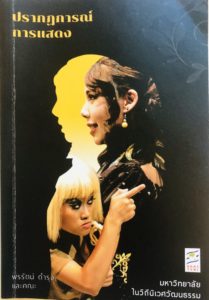
Pornrat Damrhung et al., eds.
Bangkok: Thailand Science Research and Innovation, 2019.
Reviewed by Sura Intamool (Department of English, Faculty of Humanities, Chiang Mai University; Ph.D. candidate in Theatre Studies, National University of Singapore; NUS-HYI Joint Doctoral Scholar)
The book Performance Phenomena, edited by Pornrat Damrhung and others, comprises six academic articles adapted from research related to Theatre Studies and Performance Studies funded by the Thailand Science Research and Innovation (TSRI). The selected articles, “The Retrospective Process in Directing Wenit Wanit written by King Rama VI” (ทำละคร ย้อนดูตัว: การเรียนรู้จากการกำกับการแสดงละครกวีนิพนธ์ เรื่อง เวนิสวาณิช) by Dangkamon Na-pombejra and “The Transformation of Pichet Klunchun’s Thepphanom, Theories of Thai Traditional Choreography” (ถอดบทเรียนเทพประนม ทฤษฎีแม่บทของศิลปินพิเชษฐ กลั่นชื่นเป็นการเรียนการสอน) by Julaluck Eakwattanapun, delineate essential findings from their research on how their productions were adapted from and constructively challenged Thai traditional performances as well as how the productions were ultimately well-received by contemporary Thai spectators. The findings also present how the majority of spectators immensely appreciated the artistically adaptive choices of the researchers, as mentioned earlier, which resonate with the complexity of contemporary Thai society.
Na-pombejra thoroughly presents how he produced Wenit Wanit (เวนิสวาณิช) translated by King Rama VI in 1916 from the Merchant of Venice (1596 and 1599) by William Shakespeare. The king, who reigned in Thailand from 1910-1925, perfected Wenit Wanit in the form of Thai poems with an additional purpose of educating the ethical ideas of love and mercy to Thai spectators; therefore, the play has been selected as extra-curricular reading for all high school students in Thailand. The performance text of Na-pombejra was altered to fit the Thai audience’s preference in the contemporary context, such as changing poems to poetic prose and reordering significant plot incidents. The chosen spectacles such as stage settings, costumes, and music are composed of diverse characteristics of both old and modern periods, which reflects conventional and progressive ideas within Thai society. The use of some cross-gendered performers questions some hegemonic ideas of heterosexuality. It intriguingly leads the audience to contemplate the existence of transgender people, who have been tolerated or even respected in Thai society.
In Eakwattanapun’s article, the author meticulously explains how she applied Thodkwam Thepphanom theories, constructed by the internationally recognized Thai contemporary artist Pichet Klunchun, in teaching her college students majoring in Thai traditional theatre. The theories were deployed in creating innovative dance patterns based on Thai traditional choreography. Thepphanom is the first posture in Tharam Maebot (foundation choreography). There are 64 postures for foundation choreography imitating things in daily life that ancient Thais are acquainted with. For instance, the posture Thepphanom is inspired by the action “wai” performed when Thai people greet by placing palms together. The posture Sotsoimala is an imitation of how people string flower garlands while the posture Kwangdoendong is inspired by how deer walk in the woods. Generally, Thai traditional theatre practitioners spend three to six years studying the foundation choreography. The practitioners need to slowly perform exquisite choreography; the element reflects how most Thais value slow and graceful mannerisms. The usage of Klunchun’s theories enabled Eakwattanapun to solve the critical problem when her students unskillfully applied dancing patterns from other cultures to create new performances. Subsequently, the students created aesthetically innovative performances based on the authentic concepts of Thai traditional theatre.
Even though the selected articles are appropriate for scholars and students of Theatre Studies and Performance Studies, the articles could also be beneficial to general readers, especially those interested in contemporary Thai society as it relates to the arts.
